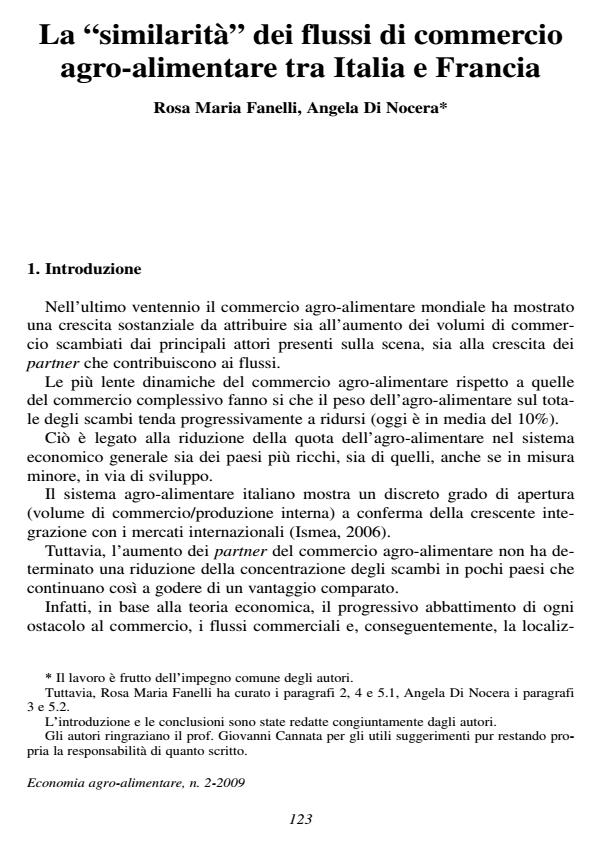La "similarità" dei flussi di commercio agro-alimentare tra Italia e Francia
Titolo Rivista ECONOMIA AGRO-ALIMENTARE
Autori/Curatori Rosa Maria Fanelli, Angela Di Nocera
Anno di pubblicazione 2009 Fascicolo 2009/2
Lingua Italiano Numero pagine 28 P. 123-150 Dimensione file 123 KB
DOI 10.3280/ECAG2009-002007
Il DOI è il codice a barre della proprietà intellettuale: per saperne di più
clicca qui
Qui sotto puoi vedere in anteprima la prima pagina di questo articolo.
Se questo articolo ti interessa, lo puoi acquistare (e scaricare in formato pdf) seguendo le facili indicazioni per acquistare il download credit. Acquista Download Credits per scaricare questo Articolo in formato PDF

FrancoAngeli è membro della Publishers International Linking Association, Inc (PILA)associazione indipendente e non profit per facilitare (attraverso i servizi tecnologici implementati da CrossRef.org) l’accesso degli studiosi ai contenuti digitali nelle pubblicazioni professionali e scientifiche
Agri-food Import and Export flows similarity between Italy and France - During the last twenty years world agri-food commerce shows an important growth owing to traded quantities increase and also to economic development of competitors on the world scene. This article is about agrifood commerce in European Union market. The aim of the paper is to compare the agri-food trade flows of Italy and France, two Mediterranean countries with very intense trade relations. For Italian agri-food system, in fact, France is the top import market and the second export market. On the basis of eurostat data, the paper focuses on import and export flows between Italy and the other European Union countries, on one side, and, on the other side, in the same way, between France and EU countries. The purpose is to value if - and at what extend - exchanged products are similar, to know if trade relationships between Italy and France are complementary rather then competitive. The first part of the paper consists of a brief introduction that is about the main trends of agrifood trade in the countries we examined. The most important data of agrifood balance are reported and discussed, and their trends examined over the period 1999-2006. The second part concerns more specifically the analysis of similarity. The analysis is based on three different kind of index: 1. the similarity and specialization indexes make possible the value the level of specialization and complementarity of Italy and France agri-food trade relations and their evolutional trend; 2. Finger-Kreinin and Hirshmann indexes measure structural changes in trade patterns over the period 1999-2006; 3. Balassa index gives information on compared advantages of competitors. As said above, we use eurostat external trade statistics, all data are related to intra European Union flows. In the database, for trade purposes, goods are classified according to Combined nomenclature in the European Union. The classification is based on the Harmonised Commodity Description and Coding System (hs) managed by the World Customs Organisation (wco); the hs uses a six digit numerical code for the coding of products. This article is part of a work in progress whose object is wider. The analysis will be extended to all Mediterranean countries, European Union Members and Third Countries, so our object is now to have a first discussion of the partial results we obtained.
JEL Code: Q17
Key words: agri-food commerce, European Union market, analysis of similarity, competitive advantage
- The role of the economic crisis on the competitiveness of the agri-food sector in the main Mediterranean countries Maria CRESCIMANNO, Antonino GALATI, Tufan BAL, in Agricultural Economics (Zemědělská ekonomika) /2014 pp.49
DOI: 10.17221/59/2013-AGRICECON
Rosa Maria Fanelli, Angela Di Nocera, La "similarità" dei flussi di commercio agro-alimentare tra Italia e Francia in "ECONOMIA AGRO-ALIMENTARE" 2/2009, pp 123-150, DOI: 10.3280/ECAG2009-002007